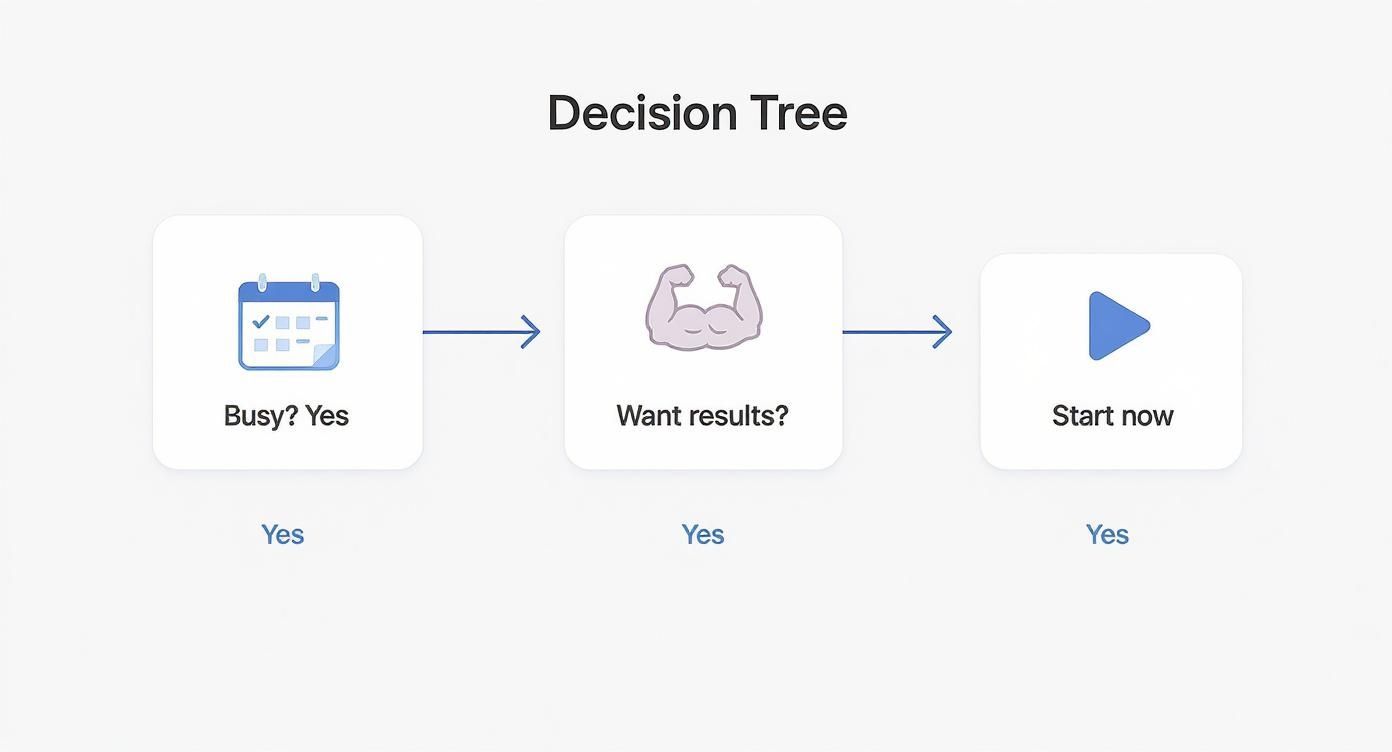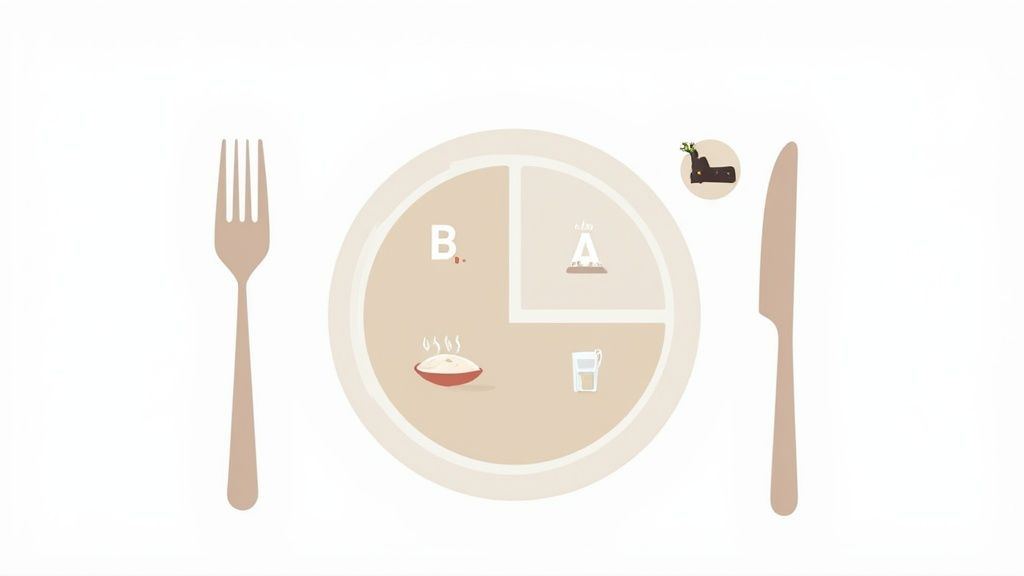A 3-day split workout routine is one of the most effective and time-efficient ways to build strength and muscle. It’s simple: you work out three times a week, focusing on different muscle groups in each session. This approach strikes the perfect balance between challenging your muscles and giving them the recovery time they need to grow stronger.
It's an ideal setup if you want to see real progress without living in the gym. This guide will walk you through everything you need to know to get started with an equipment-minimal plan you can do right at home.
Why a 3-Day Split Works So Well
Life is busy. Finding time for the gym every day is a huge ask for most of us, but that doesn't mean you can't get incredible results. This is where the 3-day split workout routine becomes your best friend.
This isn't about training less—it's about training smarter. Committing to just three focused sessions a week is the sweet spot for many people. You get enough stimulus to trigger muscle growth and, just as importantly, enough time off for your body to recover and come back stronger.
Remember, muscles don't grow while you're lifting; they grow while you're resting. By dedicating specific days to certain body parts, you give the muscles you just worked a full 48 hours or more to repair and rebuild. This is how you avoid burnout and dramatically lower your risk of injury.
The Science Behind Frequency and Recovery
The power of a 3-day split workout routine isn't just a popular opinion; it's grounded in exercise science. To get your muscles to adapt and grow, you need to train them frequently enough. Research consistently shows that hitting a muscle group more than once a week outperforms the old-school "one body part a day" approach.
For example, one study found that training muscle groups three times per week led to significantly greater strength gains than training them just once, even when the total weekly volume was the same. You can dig into these impressive training findings for yourself.
A Smart Choice for Any Fitness Level
One of the best things about this setup is how easily it adapts to your experience level.
- If you're a beginner: This is the perfect starting point. It gives you a manageable structure to learn the core movements without feeling overwhelmed or overly sore. You'll build a solid foundation of strength and good form.
- If you're an intermediate enthusiast: When those initial "newbie gains" start to slow down, a well-designed 3-day split workout routine provides the intensity and volume you need to keep progressing.
Forget the "more is always better" mindset. The real magic of a 3-day split workout routine is its efficiency. It's proof that amazing results come from quality and consistency, not just quantity.
Finding the Right 3-Day Split for You
https://www.youtube.com/embed/BmvZiGMhYXw
So, you're ready to commit to a 3-day split. That's a great choice, but now comes the real question: which split is the right one for you? The best 3-day split workout routine is the one that aligns with your goals, your schedule, and your current fitness level.
Let's explore the most common and effective options to find your perfect match. Each one organizes your training days in a unique way, which affects muscle focus, recovery time, and ultimately, your results.
The Most Popular 3-Day Splits
When it comes to structuring a three-day routine, you'll find a few tried-and-true methods. These are popular for one simple reason—they work.
Push/Pull/Legs (PPL): This is a classic for many fitness enthusiasts. You have a "push" day (chest, shoulders, triceps), a "pull" day (back, biceps), and a dedicated leg day. It’s an incredibly intuitive and balanced way to hit every muscle group with focused intensity.
Full Body: Just like it sounds, this approach has you training all your major muscle groups in every single session, three times a week. It’s a powerhouse for building foundational strength and is incredibly time-efficient. This makes it a go-to for beginners and anyone with a packed schedule.
Upper/Lower: For a three-day schedule, this one works on a rotating basis. You'll typically alternate an upper-body day with a lower-body day. For example: Upper Body (Monday), Lower Body (Wednesday), and then another Upper Body session (Friday). The following week, you'd start with Lower Body to keep things balanced over time.
This isn't some new fitness fad. Training three times a week has been a cornerstone of strength training for decades. The concept of split weight training effectiveness has been proven time and again, making it a reliable choice for anyone serious about their fitness.

This visual drives the point home: for a busy lifestyle that still demands serious fitness progress, a 3-day split workout routine is one of the most direct paths to success.
Which 3-Day Split Workout Routine Is Right for You?
So, how do you actually choose? It comes down to what you're trying to achieve and what your life looks like. I've put together this table to help you compare the big three at a glance.
Ultimately, there’s no single "best" split—only the one that’s best for you.
Think about your primary goal. Are you looking to build a well-proportioned physique? Push/Pull/Legs is a great choice. If you're all about building functional strength and making the most of your time, a Full Body routine is fantastic. And if you want a solid mix of both strength and frequency, the Upper/Lower split is a brilliant middle ground.
The Minimalist 3-Day Workout Plan

Alright, enough theory. Let's get to the practical plan that builds muscle. Here’s a complete, no-frills Push/Pull/Legs 3-day split workout routine designed to deliver serious results with minimal gear.
We've laid this out to be as straightforward as possible. You’ll perform each workout once a week, making sure to take at least one day off in between sessions. A classic Monday (Push), Wednesday (Pull), and Friday (Legs) schedule works great because it gives you the entire weekend to recover.
What You'll Need
At Bare Fitness, we believe in keeping fitness simple and accessible. You don't need a gym membership to crush this routine—just a few key items.
- A Pair of Dumbbells: Choose a weight that makes the last couple of reps in a set challenging but doable with good form.
- A Resistance Band: A simple loop band is perfect for exercises like pull-aparts and adding extra challenge to other movements.
- Your Own Bodyweight: It's the most versatile piece of equipment you'll ever own!
That’s it. Simple, effective, and ready when you are.
Day 1: Push Workout (Chest, Shoulders, Triceps)
This workout targets the "pushing" muscles of your upper body. The key here is control. Don’t just move the weight; focus on squeezing the target muscle at the peak of every repetition.
Dumbbell Bench Press: 3 sets of 8-12 reps. Lie on a bench or the floor. Press the dumbbells up from your chest until your arms are fully extended. Lower them slowly. Form Cue: Keep your elbows tucked at about a 45-degree angle to your body, not flared straight out to the sides, to protect your shoulders.
Standing Dumbbell Overhead Press: 3 sets of 8-12 reps. Stand with your feet shoulder-width apart, holding the dumbbells at your shoulders. Brace your core and press the weights straight overhead. Form Cue: Avoid arching your back—if you have to, the weight is too heavy.
Push-Ups: 3 sets to failure (as many reps as you can with good form). Progression: To make them harder, elevate your feet on a chair. Modification: To make them easier, place your hands on a raised surface like a couch or table, or perform them on your knees.
Dumbbell Tricep Kickbacks: 3 sets of 10-15 reps per arm. Hinge forward at your hips with a flat back. Lock your upper arm in place and extend your forearm straight back, feeling a strong squeeze in your tricep at the top.
Day 2: Pull Workout (Back and Biceps)
Next up, we’re hitting the "pulling" muscles. A strong back is the foundation of a strong body. For these movements, initiate the pull with your back and elbows, not by just yanking with your arms.
Dumbbell Rows: 3 sets of 8-12 reps per arm. Support yourself by placing one knee and hand on a bench or chair. Keeping your back straight, pull the dumbbell up toward your hip, squeezing your back muscles at the top before lowering with control.
Resistance Band Pull-Aparts: 3 sets of 15-20 reps. This is fantastic for posture. Hold a band with both hands, arms straight out in front of you. Pull the band apart by retracting your shoulder blades, as if you're trying to pinch something between them.
Dumbbell Bicep Curls: 3 sets of 10-15 reps per arm. Whether standing or sitting, keep your posture tall and your elbows pinned to your sides. Curl the dumbbells up, give your biceps a good squeeze at the top, and lower them slowly. Form Cue: No swinging! Use your muscles, not momentum.
Day 3: Legs Workout (Quads, Hamstrings, Glutes, Calves)
Don't skip leg day! A powerful lower body is the engine for everything you do, from lifting heavy to boosting your metabolism. This is often the toughest day of any 3-day split workout routine, so give it your all.
Pro Tip: For squats and lunges, focus on driving through your heels. This simple cue helps activate your glutes and hamstrings, giving you more power and protecting your knees.
Goblet Squats: 3 sets of 10-15 reps. Hold a single dumbbell vertically against your chest. Sit back and down, keeping your chest up and your back straight. Go as deep as your mobility allows without your form breaking down.
Dumbbell Romanian Deadlifts (RDLs): 3 sets of 10-15 reps. With dumbbells in front of your thighs, hinge at your hips by pushing your butt back. Keep your back flat and your knees just slightly bent. You’ll feel a good stretch in your hamstrings as you lower the weight.
Walking Lunges: 3 sets of 10-12 reps per leg. Take a large step forward and lower your hips until both knees are bent at about a 90-degree angle. Push off your back foot to step into the next lunge with the opposite leg.
Calf Raises: 3 sets of 15-20 reps. While standing and holding dumbbells, press up onto the balls of your feet as high as possible. Squeeze your calves for a moment at the top before slowly lowering back down.
Fueling Your Body for Real Results

Committing to a 3-day split workout routine is a fantastic start, but your hard work in the gym is only half the story. The other half—the part that truly builds muscle and gets you results—happens with your nutrition and rest.
This isn't about a restrictive diet. It’s about giving your body the raw materials it needs to repair tissue, build new muscle, and get you ready for your next workout.
The Bare Essentials of Nutrition
Let's cut through the noise. You don't need a complicated meal plan to see progress. Just focus on these three core nutrients.
Protein for Repair: Think of protein as the building blocks for your muscles. After you break down muscle fibers during a workout, protein provides the amino acids needed to rebuild them stronger. Aim for sources like chicken, fish, eggs, Greek yogurt, or plant-based options like lentils and tofu.
Carbohydrates for Energy: Carbs are your body's primary fuel source. They give you the energy to push through those tough sets. Stick with complex carbs like oats, brown rice, quinoa, and sweet potatoes for sustained energy.
Healthy Fats for Function: Healthy fats are vital for hormone production and overall health. Sources like avocado, nuts, seeds, and olive oil play a crucial role in your body’s recovery and growth.
Your plate doesn't need to be perfect, just purposeful. A simple post-workout meal of grilled chicken (protein), a sweet potato (carbs), and a side of avocado (fats) is incredibly effective. It's simple, it supports your goals, and it works.
Overlooked Secrets to Success: Hydration & Sleep
Beyond your plate, two of the most powerful tools for recovery are completely free. Unfortunately, they're often the first things people sacrifice.
Prioritizing hydration and sleep is non-negotiable if you want the most out of your 3-day split workout routine. Being even slightly dehydrated can tank your performance. Poor sleep directly blunts muscle protein synthesis—the very process that builds muscle.
Aim for plenty of water throughout the day and 7-9 hours of quality sleep a night. It's the best insurance policy for your hard work.
How to Keep Progressing and Avoid Plateaus

Starting a new routine is exciting. That initial burst of progress feels amazing, but the real challenge comes when things start to slow down. So, how do you make sure your 3-day split workout routine keeps delivering results?
The answer is a core principle of strength training: progressive overload.
Put simply, progressive overload means continually making your workouts a little bit more challenging over time. Your body is incredibly adaptive. To keep getting stronger and building muscle, you have to give it a new challenge to overcome. This is precisely why how training frequency impacts muscle growth is so important; a 3-day split provides the perfect structure to apply these challenges consistently.
Smart Ways to Apply Progressive Overload
Progressive overload isn't just about lifting heavier weights. That's one way, but there are smarter, safer methods to keep making progress. Focus on improving just one thing at a time.
- Increase the Weight: This is the classic approach. Once you can comfortably complete all your reps and sets (e.g., 3 sets of 12) with perfect form, it's time to try a slightly heavier dumbbell.
- Add More Reps: Can't jump up in weight yet? No problem. Stick with the same weight and aim to squeeze out one or two more reps per set than you did last time.
- Do Another Set: If you normally do three sets of an exercise, try adding a fourth. This increases your total training volume—a powerful stimulus for muscle growth.
The goal is gradual improvement. We're not looking for giant leaps. One extra rep or a slightly heavier weight each week adds up to massive long-term success.
Advanced Techniques for Minimal Equipment
What if you train at home and you've maxed out your dumbbells? You're not stuck. You can still apply progressive overload by making the exercises themselves more difficult.
Making Exercises Harder:
- Slow Down the Tempo: This is a game-changer. Try taking a full 3-4 seconds to lower the weight on each repetition (this is called the "eccentric" phase). This increases the time your muscles are under tension, forcing them to work much harder.
- Add a Pause: Build control by adding a 1-2 second pause at the most challenging part of the movement. For example, hold at the bottom of a squat or pause with the dumbbells just above your chest during a press.
- Improve Your Range of Motion: Can you sink your squat just a little deeper? Can you get a better stretch at the bottom of a dumbbell row? Moving a weight through a greater, controlled distance is a fantastic way to progress.
By consistently finding small ways to challenge yourself, you'll ensure your 3-day split workout routine never gets stale. The formula is simple: listen to your body, track your progress, and always aim to be just a little bit better than last time.
Answering Your Top Questions
Jumping into any new workout plan brings up questions. That's smart! Let's clear up some of the most common ones so you can start your 3-day split workout routine with confidence.
Can I actually build muscle working out only 3 days a week?
Absolutely. For many people, it's one of the best ways to do it. The key isn't how many days you work out, but the quality of the work you put in. Three intense, focused sessions a week, combined with progressive overload, is plenty to trigger significant muscle growth.
Plus, a three-day schedule gives you ample recovery time. Remember, that's not downtime; it's grow time. Your muscles build back stronger during rest, not during the workout itself.
What should I do if I miss a workout?
Life happens. Don't stress about it. The worst thing you can do is try to cram two workouts into one day to "catch up." That’s a quick path to burnout or injury.
The best approach is to just pick up where you left off. If you miss Wednesday's "Pull" workout, do it on Thursday and push your "Leg" day to Friday or Saturday. Long-term consistency is far more important than short-term perfection. It’s better to adjust the week's schedule than to skip an entire part of your 3-day split workout routine.
When is it time to change my workout routine?
Don't fall into the trap of changing things up too soon. You need to give this program at least 8-12 weeks to see real results. Your body needs that time to adapt and get stronger with the current exercises.
During these first few months, your focus should be on progressive overload—adding a little weight, an extra rep, or another set. After that, you could swap an exercise or two to keep things fresh, but the foundational Push/Pull/Legs structure can work for a very long time.
Is this a good routine for weight loss?
It's a fantastic routine for fat loss. The strength training you'll be doing builds lean muscle, and muscle is metabolically active. The more muscle you have, the more calories your body burns all day long, even when you're resting.
When you pair that metabolic boost with smart nutrition (like being in a small, sustainable calorie deficit), you create the perfect environment for losing fat while keeping—and even building—hard-earned muscle. This helps you achieve a strong, toned physique.
Ready to build a stronger, healthier you with a plan that actually fits your life? At Bare Fitness, we specialize in providing simple, effective workout guides that deliver real results without the need for a gym.
Explore more minimalist fitness solutions at barefitness.com



















